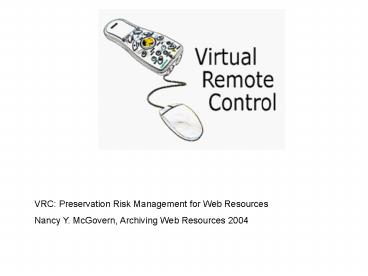VRC: Preservation Risk Management for Web Resources - PowerPoint PPT Presentation
1 / 26
Title:
VRC: Preservation Risk Management for Web Resources
Description:
the VRC toolkit needs more than just Web crawlers. VRC Toolbox ... Leverage tools beyond crawlers. Value of resource models for access & preservation ... – PowerPoint PPT presentation
Number of Views:26
Avg rating:3.0/5.0
Title: VRC: Preservation Risk Management for Web Resources
1
VRC Preservation Risk Management for Web
Resources Nancy Y. McGovern, Archiving Web
Resources 2004
2
VRC Funding
- Part of a 4(5)-year NSF-funded project
- supported by the Digital Libraries Initiative,
Phase 2 (Grant No. IIS-9905955, the Prism
Project) - Also partially funded by a grant from
The Andrew W. Mellon Foundation - Political Communications Web Archiving
http//www.crl.edu/content/PolitWeb.htm
3
Current Team
- Anne R. Kenney, Research Advisor
- Nancy Y. McGovern, Project Manager
- Richard Entlich, Sr. Researcher
- William R. Kehoe, Technology Coordinator
- Ellie Buckley, Digital Research Specialist
4
Research
- "Preservation Risk Management for Web Resources
Virtual Remote Control in Cornell's Project
Prism" - by Kenney, McGovern, et al, in DLib Magazine,
January 2002 - http//www.dlib.org/dlib/january02/kenney/01kenney
.html - "Virtual Remote Control
- Building a Preservation Risk Management Toolbox
for Web Resources" - by McGovern, Kenney, et al, in DLib Magazine,
April 2004 - http//www.dlib.org/dlib/april04/mcgovern/04mcgove
rn.html
5
Virtual
- because VRC develops models
- to represent essential features of selected Web
sites - that enable ongoing monitoring over time
- to identify, respond to, and mitigate potential
risks to the site integrity and longevity
6
Remote
- because VRC is intended for use by cultural
heritage institutions interested in the longevity
of Web resources - that reside on remote servers
- not owned or managed by the monitoring
institution
7
Control
- because at the most proactive end of the VRC
approach, a monitoring organization may act to
protect another organization's resources - by agreement or implicit consent
- through notification and/or action
8
Types of Web Resources
- Two types of initiatives for monitoring and/or
capture of - Web-based publications Web site as a means
- All (or a subset) of a Web site consisting of
pages within a boundary defined by a URL - or a
portion of one Web site as an end (VRC)
9
Risk Factors
- Organizational Context
- Combination of indicators
- Monitoring (change/loss over time)
- Triggers (events, organizational, upgrades)
- Degradation of site management indicators
10
VRC Stages
- Identification
- Analysis
- Appraisal
- Strategy
- Detection
- Response
11
Human Tool Scenario
- 1. Identification
- Human identify Web resources of interest
- Toolbox verify list, expand list
- 2. Analysis
- Toolbox crawl sites, generate characterizations
- Human accept/revise characterizations
- 3. Appraisal
- Human define/review attributes of value
- Toolbox support appraisal, capture results
12
Human Tool Scenario
- 4. Strategy
- Human develop/review strategies
- Toolbox plot appraisals, compile strategies
- 5. Detection
- Human define risk parameters
- Toolbox identify/assess risks propose responses
- 6. Response
- Toolbox propose risk response based on rules
automatic response for some risk categories - Human monitor automated responses select
response based on recommended actions
13
Risk Display Grid
14
Monitoring Layers
15
Web Crawling
- traversing Web sites via links
- a capability common to most tools, but with
different purposes and results - the VRC toolkit needs more than just Web crawlers
16
VRC Toolbox
- Identify tools for each stage (adopt, adapt,
define, devise) - Leverage existing apply to longevity
- Analyze steps - automated and manual
- Formalize protocol
- Provide a framework to map existing, plug gaps
with developments
17
VRC Toolkit
- Development steps
- extensive literature review
- development of tool categories
- definition of categories and test protocols
- survey existing tools for evaluation
- select representative for testing
- highlight findings in category summaries
18
Tool Categories
- Link checkers
- Site monitors
- Web crawlers
- Site managers
- Change Detectors
- Site Mappers (includes visualization)
- HTML Validators
19
(No Transcript)
20
(No Transcript)
21
(No Transcript)
22
VRC and Other Approaches
- Risk Management Records Management
- Passive (monitor) ? active (capture)
- Lifecycle support selection to capture
- Human (curator) tool interaction
- Structural and change models of resources
- Promulgate preservation practices
- Understand Web resources and risks
23
Characteristics Benefits
- Comprehensive tracking that include archival and
non-archival - Management of pre-agreement interests
- Leverage tools beyond crawlers
- Value of resource models for access
preservation - Overkill for simple capture
24
Access
- is not the focus of the research, but
- Presumes OAIS environment
- Treats pages and sites as objects
- View instances over time, related topical
resources over time - Safety net of last best version
25
Preservation
- Capture as active option
- Records management-like control monitor change
at varying levels - Incremental capture deconstruction
- Format-level and page-type management
26
For more info on VRC
- nm84_at_cornell.edu
- http//irisresearch.library.cornell.edu/VRC/































